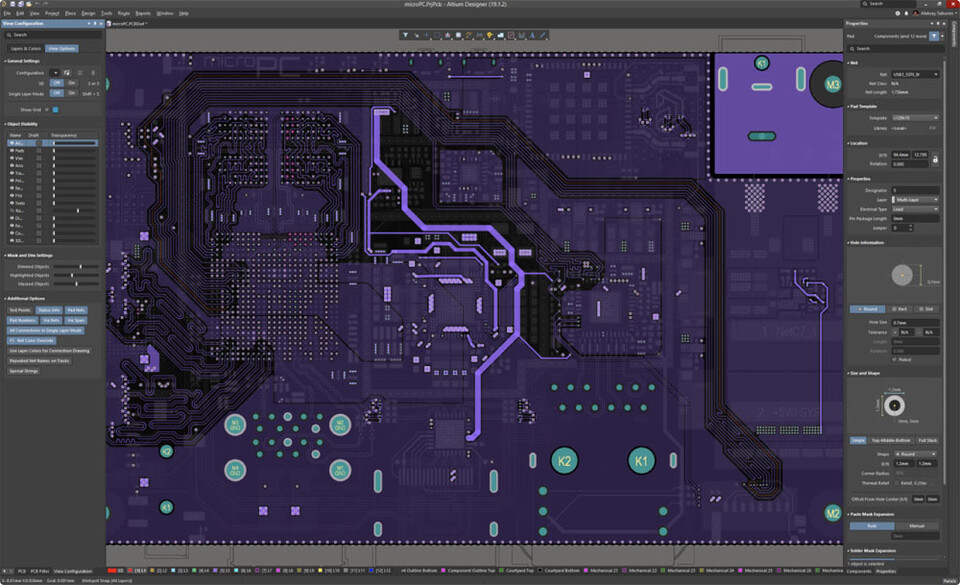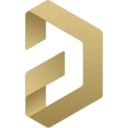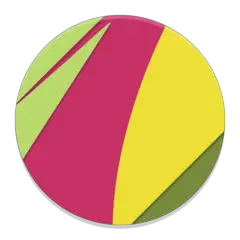|
|
Cycle through the defined Width-Gap value pairings available for the differential pair being routed, through the applicable Differential Pairs Routing rule (Min Width-Min Gap --> Preferred Width-Preferred Gap --> Max Width-Max Gap) |
||
|
|
Switch to the next enabled (and rule-permitted) layer, dropping a via |
||
|
|
Switch to the previous enabled (and rule-permitted) layer, dropping a via |
||
|
|
Switch to the next enabled (and rule-permitted) signal layer, dropping a via |
||
|
|
Switch to routing on the corresponding routing (signal) layer (dropping a via to do so). The number can be obtained from the prefix to the layer name ([n]), on the layer tab at the bottom of the main workspace. Alternatively, the number can be acquired from the pop-up window accessed through the Ctrl + L shortcut. |
||
|
|
Access a pop-up window of available routing layers. Click an entry to switch to that layer (dropping a via to do so). The number to the right of each entry ([n]) can be used to switch to that layer directly, without popping this window. |
||
|
|
When routing from a multi-layer pad or via, switches the layer for the current connection to the next signal layer defined for that pad/via |
||
|
Note: This feature works only when the routing is started from the pads/vias and before the first segments are committed.
|
|||
|
|
Add fanout via, tool immediately waits for next fanout to route and via to place |
||
|
|
Add a via without changing layer |
||
|
|
Enable subnet swapping |
||
|
Note: If no swappable target subnets are available, a message to this effect will be presented in the Messages panel.
|
|||
|
|
Swap target subnet - cycles through all swappable target subnets |
||
Advertisement
|
|
Cycle through the enabled modes as you route |
||
|
|
Cycle through the four different component selection modes |
||
|
|
Display or hide connection lines |
||
|
|
Cycle Glossing Effort mode (Weak --> Strong --> Off) |
||
|
|
Temporarily disables gloss cycling |
||
|
|
Cycle through the three glossing settings (Off, Weak, and Strong) during routing or sliding. |
|
|
Access the Interactive Routing mode of the Properties panel in which you can change routing preferences on-the-fly, as well as modify properties of the bus routing being placed |
||
|
|
Cycle through the four available corner modes (45 degree, 45 degree with arc, 90 degree, 90 degree with arc) |
||
|
Note: If the Restrict To 90/45 option is enabled on the PCB Editor - Interactive Routing page of the Preferences dialog, the arc cornering modes will not be available.
|
|||
|
|
Toggle between corner direction sub-modes (for the relevant corner modes) |
||
|
|
Reduce the radius of the arc (by 1mil/0.025mm increments) when in arc cornering placement mode |
||
|
|
Reduce the radius of the arc (by 10mil/0.254mm increments) when in arc cornering placement mode |
||
|
|
Increase the radius of the arc (by 1mil/0.025mm increments) when in arc cornering placement mode |
||
|
|
Increase the radius of the arc (by 10mil/0.254mm increments) when in arc cornering placement mode |
||
|
Commits the routing up to the current cursor position and places the tracks |
|||
|
or
|
|||
|
|
Remove last segments |
||
|
|
Terminate current route. Any routing that has been committed before calling the termination is retained |
||
|
|
Auto-complete segments to target |
||
|
|
Cycle through the currently enabled routing conflict resolution modes. The modes available (including Walkaround Obstacles, Push Obstacles, Hug and Push Obstacles, Ignore obstacles, and Stop at First Obstacle) can be defined on the PCB Editor - Interactive Routing page of the Preferences dialog, and modified on-the-fly (press Tab to access the Interactive Routing mode of the Properties panel) |
||
|
Note: When interactively routing multiple traces, the AutoRoute On Current Layer and AutoRoute On Multiple Layers modes are not available.
|
|||
|
|
Toggle automatic loop removal feature on/off |
||
|
|
Toggle the display of clearance boundaries |
||
|
|
Choose the required track width from available predefined favorite routing widths in the Track mode of the Properties panel |
||
|
|
Choose the required via size from available predefined via sizes, sourced from one or more associated via templates. The Choose Via Sizes dialog will appear with which to do so |
||
|
|
Cycle through routing width sources (User Choice --> Rule Minimum --> Rule Preferred --> Rule Maximum) |
||
|
Note: With User Choice, routing widths are defined and managed in the Favorite Interactive Routing Widths dialog.
|
|||
|
|
Cycle through via size sources (User Choice --> Rule Minimum --> Rule Preferred --> Rule Maximum) |
||
|
Note: With User Choice, via sizes are defined through via templates - locally to the active PCB document, or through associated Pad Via libraries (*.PvLib).
|
|||
|
|
Cycle through available via patterns (aligned or staggered) |
||
|
|
Switch to the next enabled (and rule-permitted) layer, dropping a via |
||
|
|
Switch to the previous enabled (and rule-permitted) layer, dropping a via |
||
|
|
Switch to the next enabled (and rule-permitted) signal layer, dropping a via |
||
|
|
Switch to routing on the corresponding routing (signal) layer (dropping a via to do so). The number can be obtained from the prefix to the layer name ([n]), on the layer tab at the bottom of the main workspace. Alternatively, the number can be acquired from the pop-up window accessed through the Ctrl + L shortcut. |
||
|
|
Access a pop-up window of available routing layers. Click an entry to switch to that layer (dropping a via to do so). The number to the right of each entry ([n]) can be used to switch to that layer directly, without popping this window. |
||
|
|
When routing from multi-layer pads or vias, switches the layer to the next signal layer defined for those pads/vias |
||
|
Note: This feature works only when the routing is started from the pads/vias and before the first segments are committed.
|
|||
|
|
Add fanout via; tool immediately waits for next fanout to route and via to place |
||
|
|
Add a via without changing layer |
||
|
|
Change the spacing between neighboring routes to use the Track-Track clearance value defined in the applicable Clearance rule |
||
|
|
Decrease the spacing between neighboring routes |
||
|
|
Increase the spacing between neighboring routes |
||
|
|
Cycle Glossing Effort mode (Weak --> Strong --> Off) |
||
|
|
Cycle forward through the supported tuning patterns. Available patterns are: Mitered with Lines, Mitered with Arcs, and Rounded |
||
|
|
Cycle backward through the supported tuning patterns. Available patterns are: Mitered with Lines, Mitered with Arcs, and Rounded |
||
|
|
Toggle display of the length tuning gauge on/off |
||
|
|
Access the Accordion mode of the Properties panel in which you can define the approach used for defining the target length, and to modify properties of the accordion pattern used in the tuning on-the-fly |
||
|
|
Decrease the amplitude of the accordion pattern by the amount defined for the Amplitude Increment in the Accordion mode of the Properties panel |
||
|
|
Increase the amplitude of the accordion pattern by the amount defined for the Amplitude Increment in the Accordion mode of the Properties panel |
||
|
|
Decrease the corner (miter) radius (when using the Mitered with Lines, or Mitered with Arcs accordion patterns) |
||
|
|
Increase the corner (miter) radius (when using the Mitered with Lines, or Mitered with Arcs accordion patterns) |
||
|
|
Decrease the gap (pitch) for the accordion pattern by the amount defined for the Gap Increment in the Accordion mode of the Properties panel |
||
|
|
Increase the gap (pitch) for the accordion pattern by the amount defined for the Gap Increment in the Accordion mode of the Properties panel |
||
|
|
Toggle Amplitude Direction (starting direction) for the accordion pattern |
|
Note: The shortcuts actually available depend on the type of 3D Model being placed or moved - Extruded, Cylinder, Sphere, or Generic 3D Model. For more information, click the source link found bottom of this article.
|
|||
|
|
Access the 3D Body mode of the Properties panel properties for the 3D body object being placed/moved can be changed on-the-fly |
||
|
|
Flip the 3D body object being placed/moved to the other side of the board |
||
|
|
Toggle the display of the connection lines (ratsnest) while moving the 3D body for a component |
||
|
|
Mirror the 3D body object being placed/moved along the X-axis |
||
|
|
Mirror the 3D body object being placed/moved along the Y-axis |
||
|
|
Rotate the 3D body object being placed/moved counterclockwise around the model's X-axis by 90° |
||
|
Note: This shortcut applies to Generic 3D Model and Cylinder model types only.
|
|||
|
|
Rotate the 3D body object being placed/moved clockwise around the model's X-axis by 90° |
||
|
Note: This shortcut applies to Generic 3D Model and Cylinder model types only.
|
|||
|
|
Rotate the 3D body object being placed/moved counterclockwise around the model's Y-axis by 90° |
||
|
Note: This shortcut applies to Generic 3D Model and Cylinder model types only.
|
|||
|
|
Rotate the 3D body object being placed/moved clockwise around the model's Y-axis by 90° |
||
|
Note: This shortcut applies to Generic 3D Model and Cylinder model types only.
|
|||
|
|
Rotate the 3D body object being placed/moved counterclockwise around the model's Z-axis by 90° |
||
|
Note: This shortcut only applies to the Extruded model type when it is being moved.
|
|||
|
|
Rotate the 3D body object being placed/moved clockwise around the model's Z-axis by 90° |
||
|
Note: This shortcut only applies to the Extruded model type when it is being moved.
|
|||
|
|
Increase the Standoff Height for the 3D body object being placed/moved by one Snap Grid unit |
||
|
Note: This shortcut only applies to the Extruded model type when it is being moved.
|
|||
|
|
Decrease the Standoff Height for the 3D body object being placed/moved by one Snap Grid unit |
||
|
Note: This shortcut only applies to the Extruded model type when it is being moved.
|
|||
|
|
Change the view of the board (or component) in 3D so that you are looking straight down from above (perpendicular) with zero rotation |
||
|
Note: In addition, you can use the applicable drop-down field on the PCB Standard toolbar (PCB Editor), or the PCB Lib Standard toolbar (PCB Library Editor) to quickly choose from a set of predefined 3D views when viewing your board (or library components) in 3D.
|
|||
|
|
Change the view of the board (or component) in 3D so that you are looking straight down from above (perpendicular) with 90 Degree (clockwise) rotation in the X-plane |
||
|
Note: In addition, you can use the applicable drop-down field on the PCB Standard toolbar (PCB Editor), or the PCB Lib Standard toolbar (PCB Library Editor) to quickly choose from a set of predefined 3D views when viewing your board (or library components) in 3D.
|
|||
|
|
Change the view of the board (or component) in 3D so that you are looking at the board from an orthogonal perspective |
||
|
Note: In addition, you can use the applicable drop-down field on the PCB Standard toolbar (PCB Editor) or the PCB Lib Standard toolbar (PCB Library Editor) to quickly choose from a set of predefined 3D views when viewing your board (or library components) in 3D.
|
|||
|
|
Toggle a board that has flexible areas between its flattened state (no Bending Line settings applied) and its folded state (all Bending Line settings applied) |
||
|
|
Access the 3D rotational sphere. With the sphere displayed, Right-Click and drag to change the orientation of the view |
||
|
|
Copies the current view in the main design workspace to the clipboard in bitmap format (*.bmp). You have control over the resolution of the copied image via the 3D Snapshot Resolution dialog |
||
|
|
Change the view of the board (or component) in 3D so that you are looking at the board from the top side |
||
|
|
Change the view of the board (or component) in 3D so that you are looking at the board from the bottom side |
||
|
|
Change the view of the board (or component) in 3D so that you are looking at the board from the front side |
||
|
|
Change the view of the board (or component) in 3D so that you are looking at the board from the back side |
||
|
|
Change the view of the board (or component) in 3D so that you are looking at the board from the left edge |
||
|
|
Change the view of the board (or component) in 3D so that you are looking at the board from the right edge |
||
|
|
Rotate the view of the board (or component) in 3D 30 degrees left |
||
|
|
Rotate the view of the board (or component) in 3D 30 degrees right |
||
|
|
Rotate the view of the board (or component) in 3D 30 degrees up |
||
|
|
Rotate the view of the board (or component) in 3D 30 degrees down |
||
|
|
Move the view of the board (or component) in 3D 500mil left |
||
|
|
Move the view of the board (or component) in 3D 500mil right |
||
|
|
Move the view of the board (or component) in 3D 500mil up |
||
|
|
Move the view of the board (or component) in 3D 500mil down |
||
|
|
Change the view of the board (or component) in 3D so that you are looking at the board from an orthogonal perspective |
||
|
|
Access the View Configuration panel in which you can configure how the board is rendered in 3D |
||
Advertisement |
|||
|
|
Toggle measurement units between metric and imperial - the displayed measurement values will update accordingly |
||
|
|
As you move the cursor over a 3D object, use to select a specific face of that object |
||
|
|
Clear all currently displayed measurements in the 3D workspace |
||
|
Sub-menu
|
|||
|
|
Open the Align sub-menu |
||
|
|
Open the Toolbars sub-menu |
||
|
|
Open a pop-up menu with Snap Grid commands |
||
|
|
Open the Component Placement sub-menu |
||
|
|
Open the Jump sub-menu |
||
|
|
Open the Panels sub-menu |
||
|
|
Open the Move sub-menu |
||
|
|
Open a pop-up menu of Connection/Jumper display commands |
||
|
|
Open the right-click Options sub-menu |
||
|
|
Open the Select sub-menu |
||
|
|
Open the Route sub-menu |
||
|
|
Open the DeSelect sub-menu |
||
|
|
Open the right-click Filter sub-menu |
||
|
|
Open a pop-up menu with zoom commands |
||
|
Batch Component Editing Mode
|
|||
|
|
Clear the content of the currently selected editable cells and copy that content to the clipboard |
||
|
|
Copy the content of the currently selected editable cells to the clipboard |
||
|
|
Paste content from the clipboard into the currently selected editable cells within the component definitions region of the document |
||
|
|
Clear the content of the currently selected (and editable) cells in the component definitions region of the document |
||
|
|
Remove the currently selected component definitions from the document |
||
|
|
Cut the selected component definition(s) from the document and add them to the clipboard |
||
|
|
Copy the selected component definition(s) to the clipboard |
||
|
|
Clone the selected component definition |
||
|
|
Paste one (or more) component definitions from the clipboard into the component definitions region of the document |
||
|
|
Access the Manufacturer Part Search dialog in which you can browse for required components across enabled supplier's online part databases. Selected components will be used to create one or more new component definitions in the active Managed Component document |
||





What is your favorite Altium Designer hotkey? Do you have any useful tips for it? Let other users know below.
1083159
486840
405105
346571
294234
268808
18 hours ago
2 days ago
2 days ago Updated!
2 days ago
4 days ago
4 days ago
Latest articles